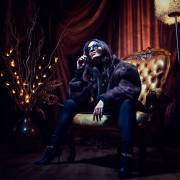Why you should trust the meter
After my workshops a lot of students switch to the use of a light meter.
They see how quick it is to setup the lights, meter the background, make sure there is detail in whites or blacks and much much more but that’s “only” part of the story. Let me tell you two stories that are real life stories and will show you a different side of why to use a meter….
The workshop story
A while ago I taught a workshop for a group of professional photographers (always a tough crowd), most of them (to my surprise) did not use a meter. After my story about why to use a meter and telling them that it was really a great tool to make sure you get what you want it was time for my photoshoot. Now believe it or not but the first shot I took was terrible, whites were all blown, blacks were blocked up and it was just plain terrible….. Some of the people in the crowd were a bit like “yeah, sure that’s why we don’t use a meter”, and some asked “ok, so now you’re gonna tweak the lights, right ?”
I surprised I think the whole crowd when I did not change anything on the lights but asked for the remote of the projector. In a few seconds I changed the brightness and contrast settings and the image looked the way I intended, now I hear you think “yeah sure, that’s not the way to do it”, well actually they also asked me about that (of course), so to prove my point I reset the projector and showed a grayscale 10 step bar. On the non adjusted settings there were only a few bars visible. And after setting the brightness and contrast all bars were shown, and also the image was showing up correctly.
The Glyn Dewis lens story
During the first “Frank Doorhof and Friends” workshop there was a small problem with one of the light setups.
I metered the lights for Glyn to F11, however when he shot the setup it was at least 2-3 stops over exposed and he asked me to change the lights, now don’t get me wrong, I will do everything my guests ask however not in this case :D, we checked his camera and when there was nothing wrong I asked one of the students to shoot the scene, which turned out spot on, when we changed Glyns lens the problem was clear, that lens performed flawless, in other words the aperture on Glyns lens is probably stuck.
The real message of this story
When you are using a meter you are not only speeding up your workflow and making it more accurate… you are actually building a foundation you can trust. When you’re working on location and have to work with less than ideal monitoring situations you know that with the meter if it’s metered correctly it will be ok. I’ve seen shooters adding loads of lights to give just a LITTLE shadow detail on their screens (back of the camera or laptop) and finding out later that they added way too much. Now that’s not a real problem, you can always darken a shot, however with the viewing angle of some laptops you can easily be fooled that you think there is a lot of shadow detail while in reality you are way too dark meaning you will have a lot of noise if you want to recreate that look in Photoshop afterwards…..
For me the meter is an essential tool in my photography, it does not intervene with the creative process, it’s just a way to get my starting point really really quick and accurate and after that I can build from that, and trust me, it happened many times that I judged my images on my screen and thought it was going wrong but I did not change a thing and luckily found out the day after in the studio that the meter was indeed right, and that saved me a lot of time over the years 😀




I love my Lightmeter. I love yours too with that custom new trigger that lets you adjust your lights, Thanks Frank for the nice post, Tom
After the workshop I followed last spring at your studio, I bought myself a Seconic 758. I am very glad with this investment. It saves a lot of time when setting up the lights and also a lot of “clicks” on my camera (saves the shutter 😉 )
I think there is not much to say about it : it’s cool, it goes fast and when you got what is f4,6 – for example – (4 plus 2/3 of a stop) it is the most easy tool to use. But what about the calibration? You can calibrate the meter (= teach him the mistakes of your cams so it gives you the correct exposure for YOUR cam). But I am not so convinced about it, I mean about the way to get the calibration correctly done. Well, I have to say that I am satisfied with the results without calibration. But how can I be sure that the metered exposure is really the correct one ?The sekonic Greypage is very expensive. I have read your article about it but, I am just a guy with a cam and I would need a step by step explanation for dummies… I coul not get what you mean with 128.128.128. for all my pixels for the grey card were slightly different… Humm… Still a GREAT Voodoo thing !!!! 🙂
I will keep on using anyway, don’t worry ! 🙂
You can use the Xrite colorchecker passport with the new Sekonic software.
The 128 method is just a way to get to a good point, it’s not 100% perfect but pretty close to it. The method is incredibly simple, but a lot of people overthink it. Just shoot an 18% graycard and try to get the 18% gray part around that 128 point that’s all.
But make sure to do it in your workflow for RAW, so if you shoot tethered with C1 but work in Lr or PS make sure to do the calibration on Lr or PS.
I finally understood your setup to use 1/10ths on the meter to match the strobes, I was stuck on the setup to match the camera 1/3 steps. No any more, just need to practice and again try to calibrate with 1/10ths to see how well that works compared to 1/3 steps. I just wise I had understood meters before purchase of the 358 model and spend the extra for the high end one with the spot meter feature. The spot add on for 358 is way too much, so will live without it for now.
Sorry that I have been away way too long , but I am back again.
Welcome back